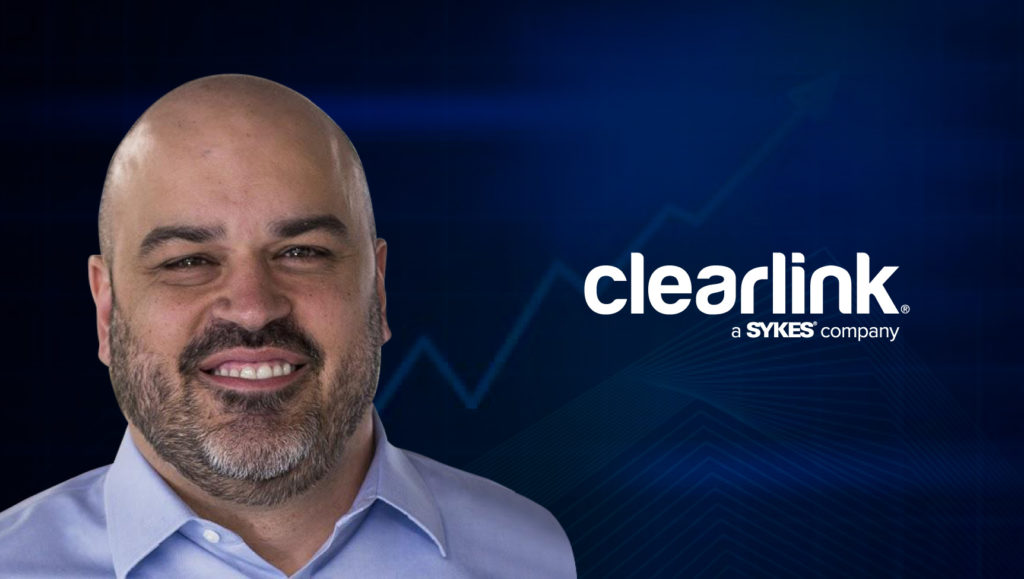Business Expertise
Tell us about your journey in sales. What attracted you to be part of Clearlink?
What attracted me to Clearlink overall was the fact that they were a growing company. Everyone I initially met with was full of energy and enthusiasm.
I actually started in finance, though. I saw an opportunity to solve some complex challenges—that I actually thought were pretty exciting—and I knew I would be given the autonomy to figure things out. So I could tell that there would be a great sense of fulfillment from my work, and that is ultimately what came to fruition.
A few years later, I switched to the sales organization; the lure there really was the team I would be working with—people who loved winning and meeting challenges head-on. Our sales team has always had a track record of being put in head-to-head competitions with our brand partners or with our competitors. And consistently, if not every single time, we win. I could see that team—those I would soon work with—absolutely thrived in that environment. That was an environment I wanted to be in.
Tell us how you achieve Marketing-Sales alignment at Clearlink.
On the technology side, we certainly do a lot to enhance the customer experience—no matter if it’s an online buy flow, a chat experience, or a call experience. For example, we create a feedback loop that changes the way we route customers, whether that’s the sales agent that they’re sent to or the type of platform that we put them through. So there’s a constant feedback loop there—using historical and location-based customer information, for example, as well as marketing campaign-specific details.
This allows us to be extremely proactive in how we treat each customer—now and in the future. When a new customer comes in, based on the vast data we have, our AI-fueled tools will decide the outcome of how we treat them in the sales environment.
Recommended: Sales Call Analytics Is The Difference Between Winning And Losing Customers
Furthermore, day-to-day, we have our marketing and sales teams on the same campus, working on the same brand teams. There’s ample collaboration at Clearlink—it’s how all of our teams are structured, representing an account or a brand. This really lends itself to daily collaboration.
What is the sales culture that you represent? Why is it important to build a sales-focused culture for any business?
I certainly think our Sales environment is more people-centric than most. I know most companies say they really try to get to know their people—but I know firsthand that we really do build our policies and procedures with our people in mind first. The way we structure our workforce management and the way we build our attendance policies are very different from most companies, and really put our people first and give them a lot of choice and autonomy around their schedules.
How do you achieve the Sales culture-balance at Clearlink? What percentage of this is driven by the application of technology, reporting tools, and coaching?
The way we build our scripting and the way we talk to customers is much looser and provides a lot more autonomy to the agents. We certainly give agents tools and recommendations—no one is flying by the seat of their pants—but they have a lot more freedom here to be more personable.
We also work hard to empower agents and give them opportunities to both teach and learn—whether that’s letting agents participate in crowdsource training, through our internal ClearTube technology, or offering sales agents professional development opportunities, where we train our talent to grow in the company to become coaches and then some.
And we also certainly do our fair share of unique incentives, but we aim to invest in and nurture learning and development opportunities even more.
How do you leverage AI and Automation at Clearlink?
We use AI in a number of ways at Clearlink; I can share a few examples with you. Something that I’m particularly excited about is our partnership with Google through their dialogue flow product; we use this to create a chat log for training.
Now we’ve got the opportunity for our sales agents to get on the phone with a chatbot and take an automated call with a virtual customer—an AI bot. This means our agents get experience without wasting a revenue opportunity on a live call when an agent may not be quite fully ready to take the call. And the AI technology is getting better every day, so the agent can really practice different objections and tones with the virtual customer. It’s Google’s engine that’s driving the machine learning—their Natural Language Processing (NLP) technology.
Additionally, our dynamic call routing technology both prioritizes our calls in the queue based on historical information and the profiles linked to certain campaigns—so the best calls, the ones we know have the highest propensity to sell, are sent to the top of the queue.
So, this technology identifies specific characteristics about the sales agent and their past performance, as well as specific characteristics about that call either from the phone number that they’re calling from and some geographic, demographic, kind of socio-economic data—or based on some data that we collected on them from the website that they came in on. We route that call to a specific agent based on what we know about the customer.
Another way we use AI is when forecasting our calls. Our algorithm looks at our calling history and sets baselines, predicts seasonality, and predicts call volume as our paid search positions change. It provides us a significantly more accurate call forecast, which puts us in way better staffing scenarios to not only manage our own profitability, but also enhance the customer experience given that we can provide a much quicker response to customers; they don’t have to wait in a call queue forever, for example.
Tell us how business enterprises can improve their productivity by increasing conversion with a custom AI sales platform using the Call Center data to create better customer experiences.
In addition to the AI examples I shared, I also think investing in AI chat technology is a must for anyone using chat as a platform. Natural Language Processing will only become faster and more intelligent—providing agents recommended scripting to use on the phone. I mentioned dynamic call routing earlier, but that’s one of the big advantages for Clearlink and why having marketing and sales tied together is so valuable. It really does allow us to offer more intelligent customer experiences. If you don’t have any marketing data about a customer, you can’t really make that feedback loop.
Sales Philosophy
How do you promote sales coaching to empower your sales teams to deliver on the performance targets?
We have a program called “Preparing to Coach,” which is a multiple-week course that all sales agents interested in coaching go through before they can apply to be a coach. We also offer “Principles of Sales and Influence” ongoing training for our coaches and managers, which addresses everything from developing one’s personal mindset to customer mindset. That training information is cascaded down, so our agents are then trained on the exact same content as our coaches. This helps to create and maintain a universal language that everyone on our sales floor speaks.
And, we also really do try to put our people at the forefront of every decision we make. There’s always an inherent question of what each decision means to the bottom line—that’s business—but with every decision, we stop and ask ourselves, “How will employees feel about this? What will the impact be—not just to their paycheck, but to their daily lives?”
So, we work to create as many feedback loops as we possibly can—from pulse survey data to regular connects with our employee development and employee advisor teams and then some. Our people are always top of mind.
What are the major pain points for sales-driven companies in leveraging Programmatic technologies for their own benefits?
A couple of things come to mind. One pain point is that, to a certain extent, the more you leverage technology, the more you’re taking the human element out.
As a sales organization, one of our biggest competitive advantages is our people. And keeping this new generation engaged requires so much more autonomy—we want to give them the freedom to make a real impact. And the more a company relies on technology, the more you’re also taking some of that choice or autonomy out of an agent’s hands.
If we have a more scripted environment, which in many ways is something we try to get away from, you do worry about disengaging your employee. We certainly don’t want our sales agents to feel robotic. So this is definitely a pain point sales-driven companies will face today and in the coming years.
While offering agents more scripted environments might be of help early in their career, later on, once that agent is really flourishing and using their own creativity and developed strategies to solve customer problems, they may grow frustrated with those same scripts that were once a crutch. So we’re always mindful of the importance and necessity of engaging employees—we’re always thinking about attrition.
And, then on a more technical side, another pain point sales-driven companies will face is automation. There’s so much variability on a sales call—more so than there is on a service call, for example. So, an AI bot’s ability to learn requires them to consume so much more data for sales calls.
What are your 2019 predictions and observations on the “Role of Chatbots and AI Conversations” influencing sales journeys?
I’m really excited about what we’re doing with Google’s dialogue flow product—creating a virtual customer for sales training. It’s working incredibly well, and we’ll be bringing it into the live call sales environment.
As all of the interactions or buying experiences we face become more digital and automated, people become more comfortable buying online—more than that, they expect and demand it.
Read More: Beyond Digital Transformation: Why the Customer Will Truly Be the Focus of 2019
So, sales organizations must become more agile and create more ways to interact with customers. We need to be able to disposition our customer very early on. There could be five to ten different paths we could go based on something that we know about them. That path could be a chat, it could be an online buy flow, it could be an outbound phone call, it could be an inbound call, and even if any one of those, there could be two or three different paths as well.
With each one of those possible outcomes, we need to get more dynamic with the way we treat our customers—give them more options of how they want to interact with us, both on the phone and off the phone, and everything in between.
We have a leg up, given that Clearlink also has digital marketing and data science organizations.
Recommended: SalesTech Interview With Michael Cibelli, SVP of Sales at Zailab
This means we have more information about that customer than most do in a sales environment. With the data we have, we always aim to expand our offerings to people and be more flexible to what their want is. We can’t expect the one size fits all approach to work anymore. It just won’t. Customers will go to a competitor to find the sales approach that they want if you don’t offer it.
How do you prepare for an AI-centric world as a sales leader?
You must understand your customers as well as the opportunities you have to optimize.
A company may think they understand their customers and have ample data—but they may struggle to actually interpret and understand that data. Investing in these resources is a must, and from there, your data must be actually usable for some sort of bot to learn from. AI is useless without accurate data.
Furthermore, if I don’t have multiple possible outcomes, what actual impact will any data have?
So, Sales teams must always consider the applicability of data—not just collecting data for the sake of having data. So again, we must all become more flexible and offer customers more opportunities and choices. You have to have choices available, and know what they are, or the AI is somewhat wasted.
Thank You, Adam, for answering all our questions. We hope to see you again, soon.
Clearlink’s strategy combines the best people with the smartest technology to provide intelligent marketing, sales, and data science solutions for the world’s leading brands. This connected approach to the customer experience results in a partnership committed to innovative thinking, rapid deployment, and impactful, long-term growth.
Adam Mergist is Chief Sales Officer and President of Home Services at Clearlink, an award-winning digital marketing, sales, and technology company and a trusted partner for Fortune 500 companies since 2003.
For well over a decade, Adam has served in leadership roles ranging from finance, data science, operations, and sales. Today he leads the entire sales organization at Clearlink.




















